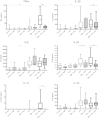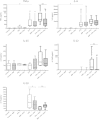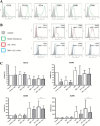Modulation of pro-inflammatory activation of monocytes and dendritic cells by aza-bis-phosphonate dendrimer as an experimental therapeutic agent
- PMID: 24745366
- PMCID: PMC4060464
- DOI: 10.1186/ar4546
Modulation of pro-inflammatory activation of monocytes and dendritic cells by aza-bis-phosphonate dendrimer as an experimental therapeutic agent
Abstract
Introduction: Our objective was to assess the capacity of dendrimer aza-bis-phosphonate (ABP) to modulate phenotype of monocytes (Mo) and monocytes derived dendritic cells (MoDC) activated in response to toll-like receptor 4 (TLR4) and interferon γ (IFN- γ) stimulation.
Methods: Mo (n = 12) and MoDC (n = 11) from peripheral blood of healthy donors were prepared. Cells were preincubated or not for 1 hour with dendrimer ABP, then incubated with lipopolysaccharide (LPS; as a TLR4 ligand) and (IFN-γ) for 38 hours. Secretion of tumor necrosis factor α (TNFα), interleukin (IL) -1, IL-6, IL-12, IL-10 and IL-23 in the culture medium was measured by enzyme-linked immunosorbent assay (ELISA) and Cytokine Bead Array. Differentiation and subsequent maturation of MoDC from nine donors in the presence of LPS were analyzed by flow cytometry using CD80, CD86, CD83 and CD1a surface expression as markers.
Results: Mo and MoDC were orientated to a pro-inflammatory state. In activated Mo, TNFα, IL-1β and IL-23 levels were significantly lower after prior incubation with dendrimer ABP. In activated MoDC, dendrimer ABP promoted IL-10 secretion while decreasing dramatically the level of IL-12. TNFα and IL-6 secretion were significantly lower in the presence of dendrimer ABP. LPS driven maturation of MoDC was impaired by dendrimer ABP treatment, as attested by the significantly lower expression of CD80 and CD86.
Conclusion: Our data indicate that dendrimer ABP possesses immunomodulatory properties on human Mo and MoDC, in TLR4 + IFN-γ stimulation model, by inducing M2 alternative activation of Mo and promoting tolerogenic MoDC.
Figures





Similar articles
-
Altered phenotype and Stat1 expression in Toll-like receptor 7/8 stimulated monocyte-derived dendritic cells from patients with primary Sjögren's syndrome.Arthritis Res Ther. 2014 Aug 11;16(4):R166. doi: 10.1186/ar4682. Arthritis Res Ther. 2014. PMID: 25113744 Free PMC article.
-
Comparative effects of aspirin and NO-releasing aspirins on differentiation, maturation and function of human monocyte-derived dendritic cells in vitro.Int Immunopharmacol. 2009 Jul;9(7-8):910-7. doi: 10.1016/j.intimp.2009.03.016. Epub 2009 Mar 31. Int Immunopharmacol. 2009. PMID: 19341823
-
Generating Bovine Monocyte-Derived Dendritic Cells for Experimental and Clinical Applications Using Commercially Available Serum-Free Medium.Front Immunol. 2020 Oct 16;11:591185. doi: 10.3389/fimmu.2020.591185. eCollection 2020. Front Immunol. 2020. PMID: 33178224 Free PMC article.
-
The ABP Dendrimer, a Drug-Candidate against Inflammatory Diseases That Triggers the Activation of Interleukin-10 Producing Immune Cells.Molecules. 2018 May 25;23(6):1272. doi: 10.3390/molecules23061272. Molecules. 2018. PMID: 29799517 Free PMC article. Review.
-
Curing inflammatory diseases using phosphorous dendrimers.Wiley Interdiscip Rev Nanomed Nanobiotechnol. 2022 Jul;14(4):e1783. doi: 10.1002/wnan.1783. Epub 2022 Feb 22. Wiley Interdiscip Rev Nanomed Nanobiotechnol. 2022. PMID: 35194953 Review.
Cited by
-
Biodistribution and Biosafety of a Poly(Phosphorhydrazone) Dendrimer, an Anti-Inflammatory Drug-Candidate.Biomolecules. 2019 Sep 11;9(9):475. doi: 10.3390/biom9090475. Biomolecules. 2019. PMID: 31514434 Free PMC article.
-
Effects of Cationic Dendrimers and Their Complexes with microRNAs on Immunocompetent Cells.Pharmaceutics. 2022 Dec 31;15(1):148. doi: 10.3390/pharmaceutics15010148. Pharmaceutics. 2022. PMID: 36678776 Free PMC article.
-
Repolarization of Unbalanced Macrophages: Unmet Medical Need in Chronic Inflammation and Cancer.Int J Mol Sci. 2022 Jan 28;23(3):1496. doi: 10.3390/ijms23031496. Int J Mol Sci. 2022. PMID: 35163420 Free PMC article. Review.
-
Neutral high-generation phosphorus dendrimers inhibit macrophage-mediated inflammatory response in vitro and in vivo.Proc Natl Acad Sci U S A. 2017 Sep 12;114(37):E7660-E7669. doi: 10.1073/pnas.1704858114. Epub 2017 Aug 28. Proc Natl Acad Sci U S A. 2017. PMID: 28847956 Free PMC article.
-
Dendrimers and Derivatives as Multifunctional Nanotherapeutics for Alzheimer's Disease.Pharmaceutics. 2023 Mar 24;15(4):1054. doi: 10.3390/pharmaceutics15041054. Pharmaceutics. 2023. PMID: 37111540 Free PMC article. Review.
References
Publication types
MeSH terms
Substances
LinkOut - more resources
Full Text Sources
Other Literature Sources
Miscellaneous

